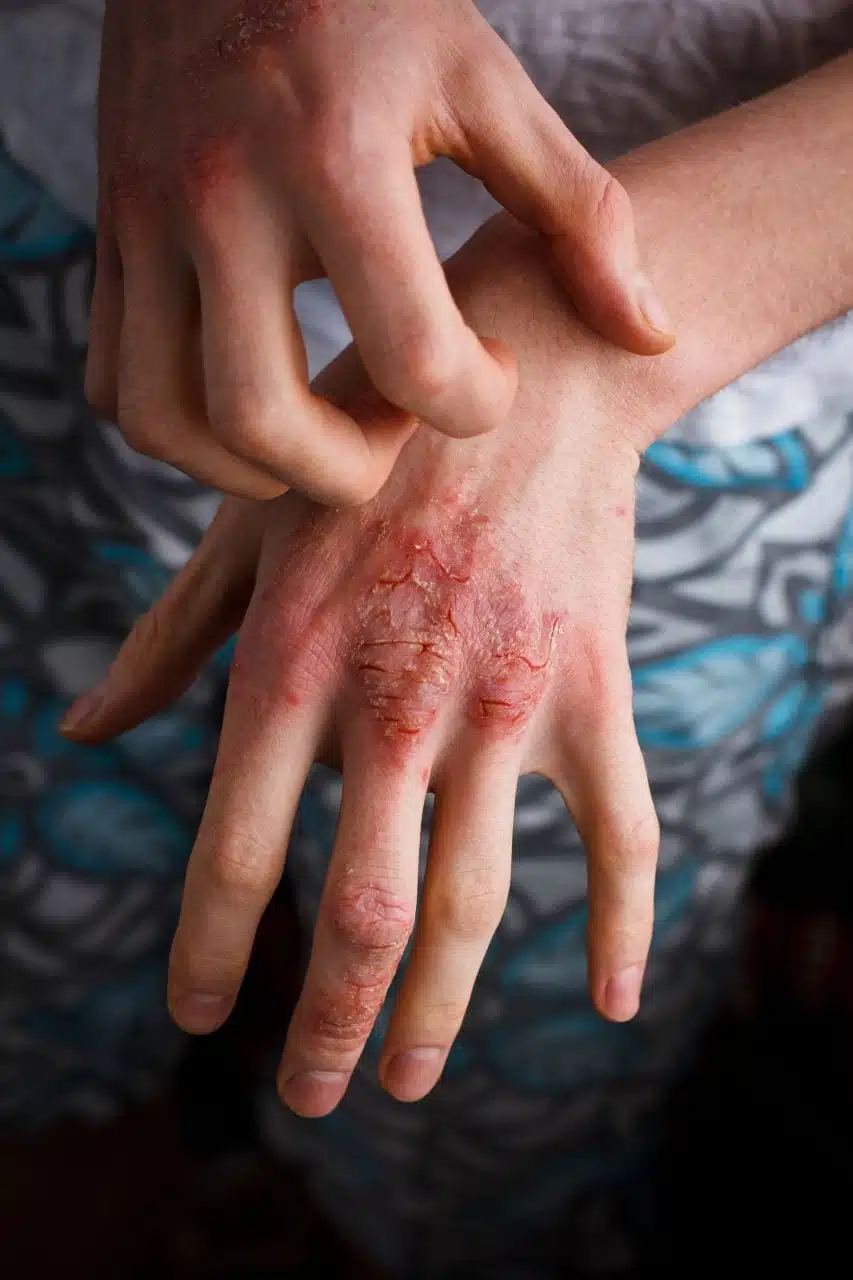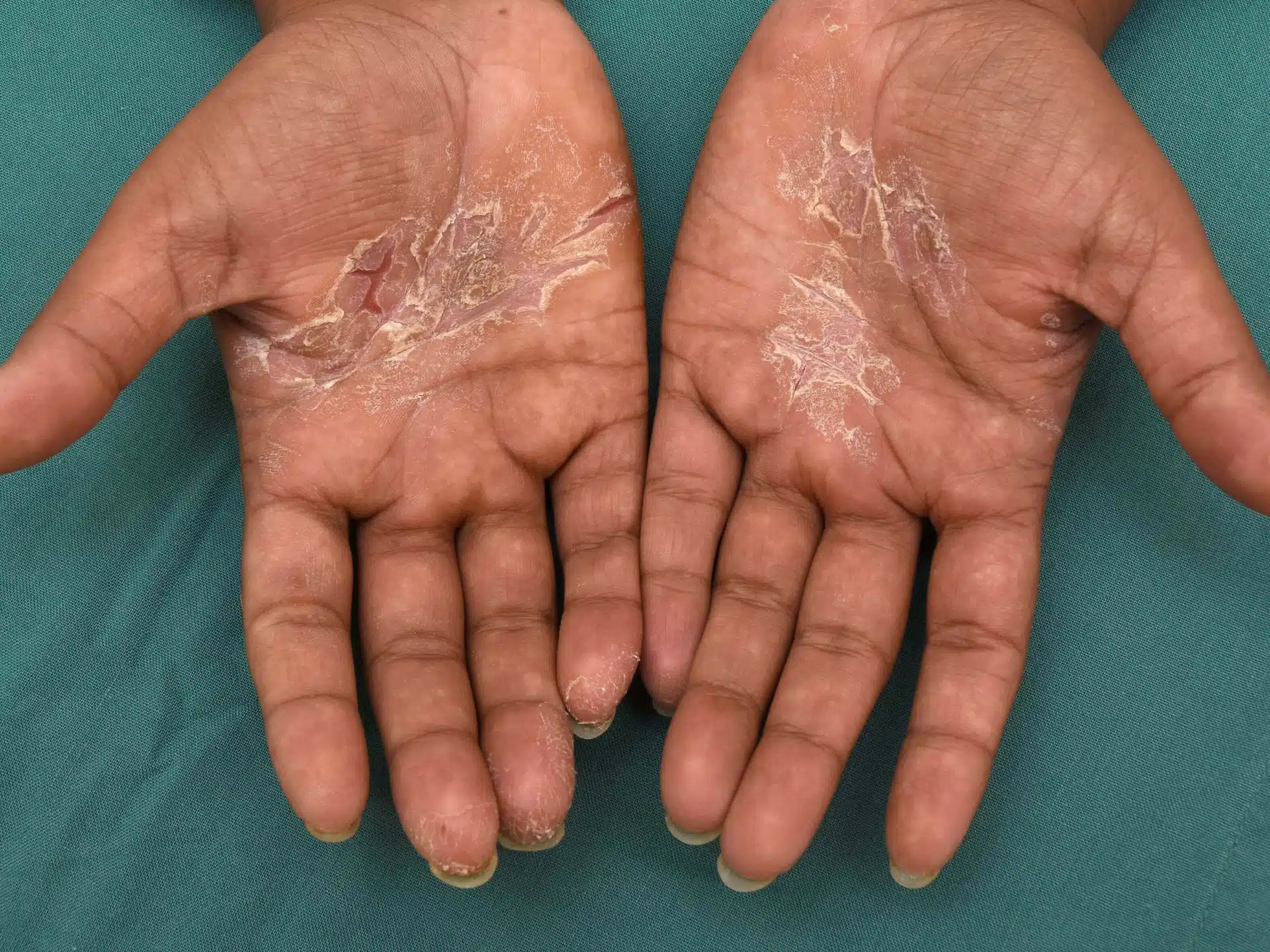Hand eczema
Jump to:
Why does eczema appear on the hands?
Practical tips for looking after your hands
Introduction

Hand eczema (also known as ‘dermatitis’) is one of the most common types of eczema. It mainly affects the palms but can affect other parts of the hand, too. The main symptoms are dry, itchy skin that is red or darker than the surrounding skin. Other symptoms include cracking, soreness and bleeding. In some cases, blisters may develop. The skin is generally dry, scaly and thickened, and the fingers can become swollen when the eczema is flaring. If the eczema is severe over a long time, the hands can become very painful, making it difficult to carry out day-to-day tasks such as doing up buttons, holding a pen or using a computer.
The skin forms part of the immune system and helps to protect against infection. It not only provides a physical barrier, but the layers of skin contain specialised cells that destroy invading foreign proteins (antigens) such as bacteria and viruses. In people with eczema, the immune system overreacts in the skin, making it inflamed and itchy.
Why does eczema appear on the hands?
Eczema can appear on the hands for various reasons. For example, the hands can be affected by irritant or allergic contact dermatitis, or both at the same time.

© Waikato District Health Board. This image is used with the permission of DermNet New Zealand, www.dermnetnz.org
Coming into contact with irritants such as dust, detergents, cleaning agents, airborne sprays, chemicals used in acrylic nails, or even frequent hand- washing or wet wipe use can cause irritant hand eczema (irritant contact dermatitis of the hands). The skin on the palms of the hands is much thicker than elsewhere on the body (apart from the soles of the feet) and is normally able to withstand a great deal of wear and tear. But when people regularly immerse their hands in detergents or solvents, the protective barrier of the skin breaks down, and eczema may develop. People who have irritant contact dermatitis often have a history of eczema in childhood.
Allergic hand eczema (allergic contact dermatitis of the hands) arises as a result of an allergic reaction to a particular substance in the environment. It is possible to be allergic to a number of different substances, but common causes of contact sensitivity include nickel, fragrance ingredients, preservative chemicals, rubber and various plants. Once a person’s immune system has identified a substance as ‘harmful’, they will react to the substance every time their skin is exposed to it, and this reaction becomes more severe on every exposure to the allergen.
When an allergic reaction of this kind is suspected, your GP should refer you to a dermatologist, who will normally carry out patch testing to try to identify the allergic cause.
Pompholyx eczema (also known as ‘dyshidrotic eczema’) is another type of eczema that affects the hands (and feet). Pompholyx eczema involves the development of intensely itchy, watery blisters, mostly affecting the sides of the fingers, the palms of the hands and soles of the feet. Some people have pompholyx eczema on their hands and/or feet with other types of eczema elsewhere on the body.
This condition can occur at any age but is most common before the age of 40. The onset of pompholyx eczema can be very sudden and the cause is unknown. It is thought that stress, sensitivity to metal compounds (such as nickel, cobalt or chromate), heat and sweating can aggravate this condition. The skin is initially very itchy, and, if you scratch, the blisters can burst, causing soreness and weeping. The skin will then dry out and often peel. Pompholyx can occur as a single episode, but for most people, it is a chronic type of eczema that will come and go with a flare lasting 2-3 weeks.
For more information, please see National Eczema Society’s Pompholyx eczema factsheet.
Treatment
It is as important to avoid any known irritants or allergens as it is to apply emollients and other treatments as necessary.
Emollients are medical moisturisers that come in different formulations. There are lotions, creams, gels, ointments and a spray. They are available on prescription from a GP and to buy over-the-counter in pharmacies. They should be used frequently throughout the day to enhance the barrier function of the skin – even when the eczema is not flaring. They keep the skin hydrated and help prevent irritants and allergens from entering it. Ointment-based emollients are the most effective type for very dry skin, but some people find them too greasy to use during the day. If this is the case for you, apply an ointment before bed and wear a pair of 100% cotton gloves overnight. Apply a cream frequently throughout the day.
A leave-on emollient or an emollient soap substitute should be used for washing, since soap removes oils from the skin and can also act as an irritant. During the Covid-19 pandemic, people with eczema were advised to wash their hands first with soap and then with an emollient, as emollients were not considered effective at removing Covid-19 particles. It is a good idea to carry around a small dispenser or pot of emollient to use for hand-washing during the day. For more information and practical tips on emollients, please see National Eczema Society’s Emollients factsheet.
Topical steroids treat flaring eczema by reducing inflammation, helping skin that is sore, cracked and red or darker than the surrounding skin. Hands usually require stronger steroids (the skin of the palms is thick), so potent topical steroids are usually prescribed (moderately potent for children). They should be used for a short treatment burst – generally 2 weeks. If the skin is infected, you may be prescribed an antibiotic treatment in the form of a cream, or even a course of tablets. For more information on topical steroids, see National Eczema Society’s Topical steroids factsheet.
Protopic ointment, a topical calcineurin inhibitor (TCI), is sometimes prescribed for treating hand eczema. TCIs have been developed for treating atopic eczema and work by altering the immune system. They are used in a different way to topical steroids. For more information on TCIs, see National Eczema Society’s Topical calcineurin inhibitors factsheet.
Wearing gloves should help protect your hands from irritants and allergens, but you will still need to establish a good skincare routine using an emollient both as a leave-on moisturiser and to wash with. Ensure that gloves give complete protection and that the insides remain dry. For general purposes and household tasks, rubber or PVC gloves with a cotton flocked lining, or worn over 100% cotton gloves, should suffice. Even when the eczema has cleared, the hands can remain very sensitive, so the use of cotton gloves underneath rubber or PVC gloves can be helpful when performing wet tasks.
Some jobs may recommend the use of barrier creams to protect employees’ hands. We would advise that people with hand eczema always use protective gloves (which should be provided by their workplace) and never barrier creams. Discuss any concerns with your Occupational Health department, which will provide the correct gloves for hand protection in the workplace.
If your hand eczema is severe, discuss the possibility of a dermatology referral with your GP. The referral may be for diagnosing contact allergy (patch testing) or for treatment, which may include a short course of oral steroids or immunosuppressants (e.g. azathioprine, ciclosporin or methotrexate). Alternatively, dermatology departments may recommend alitretinoin (Toctino) or phototherapy, as described below.
Alitretinoin (Toctino)
Toctino is an oral treatment licensed for use in adults with severe chronic hand eczema that has not responded to treatment with potent topical steroids. Toctino is not known to be helpful for treating eczema on any other part of the body. The active ingredient in Toctino is alitretinoin, a type of chemical that is naturally found in the body, and is known as a retinoid (as it is related to vitamin A). Toctino comes as a capsule in two strengths – 10 mg or 30 mg – and is taken once a day with a meal. Your doctor will decide which strength you need.
Toctino has been shown to be effective in patients with severe hand eczema. It works by reducing the inflammation associated with eczema as well as damping down the response of the immune system. The treatment period is usually 12-24 weeks, depending on how your eczema responds.
SIDE EFFECTS: The most frequent side effects are headaches, dry lips and skin, flushing, changes in blood fats (e.g. cholesterol) and decreased levels of thyroid hormone. Not everyone will experience these, but if you notice any side effects while taking Toctino, you should discuss them with your doctor, who may reduce your dose.
WARNING: Retinoids are likely to cause severe birth defects if taken during pregnancy. This means that anyone with childbearing potential must avoid becoming pregnant during treatment and for one month after stopping treatment – for example, by using two effective methods of contraception. The drug can only be prescribed if a pregnancy test is negative. Regular pregnancy tests will be taken during treatment. You should not breastfeed while taking Toctino and for a month after completing treatment.
Phototherapy
Phototherapy (UVB or PUVA), using either UVB or UVA rays administered by a special foot/hand light box, may be recommended if this treatment option is available locally to you. Assessment and treatment (2-3 times a week) would usually take place in a dermatology department.
In some areas of the UK, you may be loaned a light box so you can administer your treatment at home, although you will continue to be monitored by the dermatology department. Both UVB and PUVA courses last on average around 12-16 weeks – maybe longer for severe cases.
Practical tips for looking after your hands
- Use an emollient soap substitute or your usual leave-on emollient to wash your hands with, and avoid plain water. Pat your hands dry with a soft towel rather than rough paper towels, and then re-apply your leave-on emollient.
- Never wash your hands with soap while wearing a ring, as soap can collect under the ring and cause irritation. Rings should not be worn during housework, even when the eczema has visibly healed, as cleaning products and dust can become trapped under them and irritate the skin.
- When drying your hands, take particular care between the fingers where the skin is more prone to dryness and cracking.
- When doing the washing up, wear cotton-lined rubber or PVC gloves, or 100% cotton gloves underneath. Powder-free nitrile gloves are another option. Choose powder-free ones as powder in gloves can be an allergen. Try not to wear rubber/PVC/nitrile gloves for more than 20 minutes at a time as they can cause the skin to sweat, which can aggravate eczema. If possible use a dishwasher instead of washing up manually! Avoid direct contact with detergents, cleaning agents, solvents and stain removers.
- Do not peel citrus fruit, onions, chillies or garlic with bare hands. Many fruits and vegetables are irritants. If you do handle them with bare hands, wash your hands as soon as possible afterwards and apply an emollient.
- Wearing rings (especially those made from inexpensive metals that may contain nickel) may worsen hand eczema.
- People with a history of hand eczema need to carefully consider their choice of career, as certain occupations carry the risk of contact with substances that may cause irritation and/or allergy. These include: hairdressing, catering, healthcare professions, metal work, floristry, mechanics, domestic/cleaning work, some types of engineering, and printing.
To obtain the information on this page in a PDF format, please download our Hand eczema factsheet, below.
